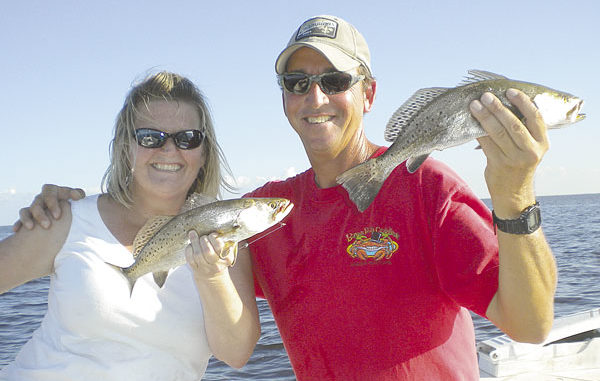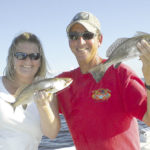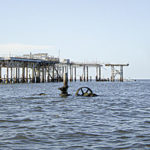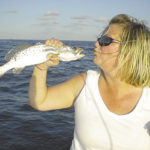
Sleep in, let the boats clear out and then head down to Black Bay for some fast trout action.
August can be a tough month for anglers along the southeast coast of Louisiana, and this month will present us with even greater challenges than usual.
Besides the normally oppressive August heat and humidity that sends fish deep and dramatically decreases the bite window, this year we’re also dealing with the oil spill from hell that just seems unending. Who could’ve dreamed it would take months to plug a hole in the floor of the Gulf? It might have been quicker to plug a hole on the moon.
Further compounding the difficulty is the fact that we’ve faced such constant changes in the closures and openings, depending on the whim of the Gulf’s tidal flow, so that we’re forced to continually check right up to the very hour of departure to make sure we don’t head out to fish in closed waters.
There were always things to check in advance — tides, moon stage, your normal check list, etc. But now you have to check to be sure the water you head to isn’t closed off and oil-coated. Plus, we’re sweating out what is predicted to be another intense tropical season.
I’ve always favored fishing over around the waters of Delacroix Island and Pointe a la Hache in August, where I’ve found the trout will still cooperate even during the dog days.
I managed to convince Capt. Jack Payne, who also owns and operates the new Sweetwater Marina in Delacroix Island (504-453-8382), that he should take me fishing again and show me where the summertime trout would be biting.
Payne agreed, and we took off in his 24-foot Kenner bay boat at 4 p.m. Normally, I’m a morning person. Early to bed, early to rise; you know, that sort of thing. My typical fishing day begins before 3 a.m., and by the afternoon I’m all tuckered out and done for the day.
But Payne is busy in the mornings with the marina, his guide service, the Wildlife and Fisheries agents who are occupying his cabins and a pest control business he runs. Plus, he was on a great bite in the late afternoon, and he was willing to take me and show me, and not just tell me. Payne’s long-time girlfriend, Cindy Berry, jumped aboard, and the three of us headed out for some shrimp danglin’ and afternoon anglin’ in the waters just off the Delacroix coastline.
Payne says there are some definite advantages to fishing the afternoons.
“The crowds have all gone home, and you’ll have very little competition for the prime spots,” he said. “Places you couldn’t get to in the morning because of all the boats are wide open in the late afternoon. And you usually can catch a good tide movement later in the day.
“Fish want to eat dinner just like you do, and when their dinner bell rings and you’ve hit the right spots with a combination of a good moving tide, decent winds and some enticing bait, the trout really turn on.”
Our first stop was a big rig just off the coast in Black Bay that I didn’t immediately recognize. I think I might have snoozed off for a few minutes on the ride out and woke up a bit disoriented. But I soon realized we were at the Wreck, a perennial summertime hotspot known for its prolific production of sizeable specks.
A boat was parked at the spot Payne wanted to fish (so much for the “you’ll have the spots all to yourself” theory), and the two guys aboard were putting a spanking on some nice trout. Another boat was trolling around the opposite end of the big rig, and Payne idled us in an unoccupied side, and dropped the trolling motor over the bow. He planned to move slowly around the rig, varying his distances, until we bumped into some action.
“There’s been some big trout coming in from out here,” Payne said. “I really plan to take us to some of the islands out here, but I wanted to take a shot here first — just in case we could catch a few whoppers.”
The plan, he explained, was for me and Cindy to fish live shrimp while he drove from the bow and tossed plastic. We fished about 4 feet under a cork for awhile, without success, and Payne struck out with the plastic as well. I switched to a Carolina rig with live shrimp and caught only the bottom and a sheepshead.
Meanwhile, the two guys parked in our spot continued to wail on the fish. Their whoops and high-fives were now beginning to grate on my nerves.
Almost an hour passed as we worked our way around the rig, giving wide berth to the other boats so as not to infringe on their action, yet we had not a single trout to show for it. By that time, one boat had left and even the whoopers had fallen silent. It was time to go.
Perhaps one drawback to an afternoon trip is the limited daylight you have to fish. It was now a bit past 5:30, and we didn’t have a trout in the boat. I was beginning to think this would be a washout. Payne reluctantly pulled up the trolling motor, and headed for one of the numerous islands in the big bay.
Black Bay and all the bays along its fringes, such as Bay Gardene, Bay Crabe, American Bay, California Bay, Long Bay and even over into Bay Lafourche and Oak River Bay, are dotted with so many islands, reefs, rigs and wellheads that you couldn’t fish them all in one summer.
“Any of them could produce some good sizes and numbers of trout,” Payne said. “If an area looks promising, stop and try it. Scout along the bank for tidal movement and signs of bait in the water. If you see mullet, try it. If you see shrimp jumping, definitely stop and try it.”
Payne likes to kill the outboard a ways off from the spot so as not to spook the fish, and then troll up closer.
“If you get some action, drop the anchor over as quietly as possible and try to stay on the bite. Just keep moving until you get some hits,” he said.
Payne also violated one of his own cardinal rules of summer fishing: “Don’t sit on a spot that isn’t producing for too long.”
I know how easy it is to make the mistake of beating a dead horse, because you know a spot holds fish. But when you fish in the summer, whether mornings or afternoons, the bite window is not open for very long.
“If I know for sure that a spot is holding fish, I’ll work it awhile and give it a chance to produce even if the action is slow, just to see if they’ll turn on,” Payne said. “That’s why I stayed at the Wreck as long as I did. I knew how good it’s been producing. It could be that the tide was slack or switching, or some subtle change might start them into a feeding frenzy.
“But you also have to throw in the towel on a spot when you see the clock ticking. You just can’t afford to stay at a non-productive spot if you want to go home with fish.”
Payne dropped the trolling motor again at a spit of an island, and slowly moved up to within casting distance, where he dropped the anchor. There was only a slight chop to the sea, and a good current moved around the island. Water clarity was good, and the whole scene seemed to have good potential. This time the plan was for everybody to fish live shrimp about 18 inches under a cork.
Cindy had her bait in the water first, and before I had time to string a shrimp on my hook, she was reeling in the first trout of the day. I quickly threw my bait to the same spot, and caught its identical twin, about 1½ pounds. From then on, it was on. We got slammed by hungry trout on almost every cast.
The live shrimp were irresistible to the ravenous trout, and they’d swallow them up as soon as they hit the water. All of the trout seemed to be poured out of the same mold, at about 1½ pounds each, with an occasional 2-pounder thrown in, and every once in a while a throwback. We’d switch to plastics and get almost the same instant hook-ups, but if we stayed with the plastic, the action would die down until we went back to tossing shrimp, and it’d start right back up again.
Once or twice Payne had to reposition the boat so we could all cast into the action, and each time he moved us with the trolling motor rather than starting up the outboard, so as not to spook the trout. It was a wise choice because we sat on the action until almost dark, and we were five fish short of our limit. Payne said we had to catch those five more fish before we could leave, and in five casts, we did.
Payne says Black Bay and the coastal bays will be red hot this month, if the oil doesn’t move in and shut it all down. Normal hotspots like Stone Island and the surrounding structures, Iron Banks, Belle Island, Battledore Reef, Telegraph Point or any of the broken, no-name islands and reefs, will produce this month.
Besides that, the fringe bays such as Bay Lafourche, Oak River Bay, Bay Gardene, Bay Crabe and American Bay will be productive.
He says to fish the islands and shorelines, concentrating at points with good water clarity and tide, with live shrimp or croakers under a cork, and tight-lining soft plastics in glow or opening night. If you see mullet along the shoreline, toss there for trout and reds, and a topwater bait could pay off with some explosive hits if the conditions are right to use them.
He says the best action won’t be confined to just the islands and reefs, but also at the various wells and rigs dotting the bay.
“You can also catch plenty of trout under the birds right now, and some of the schools have decent-sized fish in them, so you want to keep the bird option open,” he said. “But overall, Black Bay and the fringe bays are relatively simple to fish. All you have to do is make sure you’re fishing a moving tide, whether rising or falling (Payne prefers falling, but he says either will produce), scout for signs of bait in the water, approach your fishing spots as quietly as you can, and whether you troll or anchor, dangle a live shrimp or croaker either under a popping cork, freelined or just with a split shot, or a sliding sinker, and try a topwater bait or even a shallow-swimming subsurface bait.”
And don’t limit yourself to only fishing in the wee hours of the morning. You might want to consider some afternoon anglin’ and shrimp danglin.’





